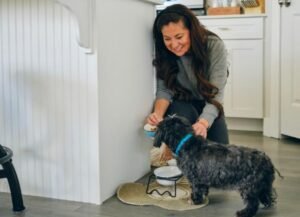Despite what some may think, walking on a leash doesn’t come naturally to dogs. Leash-walking is a human need that dogs need to learn—not something dogs are born knowing how to do.
Training a dog to walk on a leash has many components, and pet parents need to consider equipment, methods, and location. But with the right process, dogs can become comfortable on a leash. Here’s how to leash train a dog.
Why Is Leash Training a Dog Important?
Walking your dog provides exercise and mental stimulation. Leashes keep your dog safe when they’re in public, and they’re required by law in many places. Having a dog conditioned to leash life gives her more opportunities to do things with her pet parents.
A dog that’s well-conditioned to being on a leash can help prevent leash reactivity, which is a common issue. Feeling restrained can be stressful for dogs, so it’s important that your pup is used to her leash.
Leashes benefit humans too. Research shows that a person walking their dog may experience stress relief. Conversely, our stress can increase when trying to walk a dog with difficult leash behaviors.
How To Train Your Dog To Walk on a Leash
1. Build Your Relationship
The key to successfully leash training a dog is having a strong relationship. Being tethered to someone can leave some dogs feeling vulnerable, frustrated, or anxious. A relationship with your dog built on consistency, predictability, and positive reinforcement can help keep these negative emotions from arising.
If your dog seems overly distracted, avoids training, or just never listens, consider connecting with a certified behavior consultant for an assessment of your pet.
2. Get the Right Gear
Harness: Collars are great for ID tags and for showing off your dog’s personality. But for walking, a well-designed harness is recommended. Some harnesses are designed for comfort and some for control. If your dog is not a problem puller, a back-clip harness may be a good choice. If your dog already pulls and you need more control, a dual-clip harness with a training lead is a better option.
Head halter: In some cases, our dogs may be much stronger than us. This can lead to safety issues. Head halters are an option but should be used with care. Most dogs need additional training to acclimate to them, and pet parents also need to understand how to use them safely.
Leash: A flat or round non-retractable leash of an appropriate length is critical. Choosing the correct leash length depends on the dog’s size, walking habits, and the pet parent’s handling skills. Though there is no formal research on leash length, many professionals are working on leash training protocols that involve longer—not shorter—leashes.
For example, if you are walking a small or toy-sized dog, a 10-foot leash might be all you need. If you are walking a larger dog and are good at managing the length and keeping up with them, you could move to a 20- or 30-foot leash.
Bag: A multi-pouch treat bag with a waist strap that holds your treats, poop bags, phone, and keys. This keeps you organized and lets you focus on your dog instead of rummaging around for an item you need.
Marker: A marker, such as a clicker, or a word like “yes” tells your dog when they complete the correct behavior, such as walking five steps without tension on the leash.
3. Set Up Your Training Environment
Choose your environment well. Dogs need to feel safe and be free of distractions to learn new skills. Initially, keep training in and around your home before moving to quiet areas away from your home.
4. Start Off-Leash
Begin in your house, backyard, garage, or other fenced area familiar to the dog. This space should be free of distractions.
-
With your treat bag and clicker or marker word ready, face your dog and put a treat on the ground in front of you. After she comes to eat it, you should slowly turn and begin to walk.
-
As your dog begins to walk with you, watch your dog’s position. Any position that would equate to slack on a standard 6-foot leash gets marked (with a click or by saying “yes”). Give your dog a treat.
-
Gradually increase the number of steps your dog needs to take between marking and feeding. Increase the steps randomly. For example: one step, three steps, two steps, four steps, one step, etc.
-
Once the dog is routinely walking next to you, get the behavior on cue. Before you take your first steps, say the cue and begin to walk. Mark and feed the dog for walking next to you. Continue to increase the number of steps between marking and feeding randomly. Some fun cues could be, “Let’s go,” “This way,” or even “Follow me.”
5. Introduce the Leash and Harness
Repeat the above steps with your dog wearing a harness and leash. There are dogs that will hop right into their harnesses like it’s a second skin. Other dogs may hesitate, run, or hide. Some may grab, bite, or tug to avoid harnessing.
Present the leash and harness to your dog and observe her reaction. If she hesitates to move forward or takes a step back when you approach, she may need time to get more comfortable with the gear.
Pair the presentation of the harness with yummy treats. If your dog moves their head toward the harness’s opening while you are holding it, feed a few treats. Never trick your dog by luring her closer with a treat to restrain and harness them. You are simply trying to get them to feel good about the gear.
Once the harness is on, instead of going right out for a walk, allow her to wear it for short periods of time while eating treats or playing.
If your dog shows extreme responses like running, hiding, shaking, or growling, find a professional dog trainer to help with leash training.
6. Practice Walking With the Harness and Leash
Repeat step 4 while your dog is wearing the harness and leash, then start practicing leaving your home. Exiting the house or front yard can be exciting and cause your dog to pull. You may need to work a little longer to train your dog to leave home without pulling.
7. Practice Away From Home
Select an area free from distractions. Put your dog on a long leash (between 10 and 30 feet) and let her explore. Your job is to let her set the pace and sniff anything she wants for as long as she wants.
-
Once she has a chance to check out the environment, get her attention and place a treat on the ground in front of you. When she comes to eat it, take up the slack so you have 6–8 feet of the leash to work with.
-
Begin to mark and feed again for walking with you for just a few steps, then release her to go sniff and explore some more.
-
Continue adding these short training segments into your longer walks. Add your cue for walking in close. Over time, you will have a dog that will walk next to you on cue and explore when you release her.
Remember: When walking, your dog needs some choice and control over the direction and pace. Having the ability to walk by your side is important, but your pup should not be required to do it for the entire walk.
Tips for Leash Training a Dog
-
If you have an energetic dog, spend some time playing in the yard before practicing leash training exercises. This will help reduce her energy level pre-walk, allowing for a bit more focus and potentially less pulling.
-
Use high-value treats when leash training outside the home. This can help you get your dog’s attention. You can reserve a very special treat your dog only gets when leash training.
-
Try taking your dog on walks just for sniffing, allowing her to set the pace and direction.
-
Longer leashes give the dog a sense of freedom and decrease pulling by removing resistance to their movements.
-
Reinforce every time your dog pays attention to you while on leash.
What To Do If Your Dog Pulls on the Leash
Pulling is a dog’s response to leash pressure. Common causes of pulling are a slow pace, a short leash, and/or the enticement of an interesting scent.
If your dog pulls on the leash, avoid yelling, yanking the dog back, or giving collar pops (a quick jerk on the leash). Instead, it will be more effective to evaluate the dog’s training and where you are trying to walk her—if it’s a place with lots of activity, like a farmer’s market or as you are nearing a dog park, she might pull out of sheer excitement or curiosity.
For intermittent pulling, immediately stop the walk and become an immovable object. When you feel the dog relieve the tension, mark it and put a treat on the ground so she returns to you for her reinforcer.
Next, walk in the opposite direction to re-establish the training portion of the walk, or ask your dog to sit. When she sits, jog with her or lengthen the leash so she can get to the original spot she was pulling toward.
Dogs may not have an innate ability to walk on a leash, but with consistency and positive reinforcement, leash outings can be fun for both of you.
Featured Image: Getty/fotografixx




